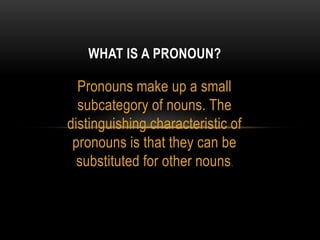Pronoun
•Download as PPTX, PDF•
0 likes•140 views
What is a Pronoun
Report
Share
Report
Share

Recommended
More Related Content
What's hot
What's hot (20)
Similar to Pronoun
Similar to Pronoun (20)
Speaking In English: A Discussion on the Parts of Speech

Speaking In English: A Discussion on the Parts of Speech
Recently uploaded
This presentation was provided by William Mattingly of the Smithsonian Institution, during the fourth segment of the NISO training series "AI & Prompt Design." Session Four: Structured Data and Assistants, was held on April 25, 2024.Mattingly "AI & Prompt Design: Structured Data, Assistants, & RAG"

Mattingly "AI & Prompt Design: Structured Data, Assistants, & RAG"National Information Standards Organization (NISO)
God is a creative God Gen 1:1. All that He created was “good”, could also be translated “beautiful”. God created man in His own image Gen 1:27. Maths helps us discover the beauty that God has created in His world and, in turn, create beautiful designs to serve and enrich the lives of others.
Explore beautiful and ugly buildings. Mathematics helps us create beautiful d...

Explore beautiful and ugly buildings. Mathematics helps us create beautiful d...christianmathematics
This presentation was provided by William Mattingly of the Smithsonian Institution, during the third segment of the NISO training series "AI & Prompt Design." Session Three: Beginning Conversations, was held on April 18, 2024.Mattingly "AI & Prompt Design: The Basics of Prompt Design"

Mattingly "AI & Prompt Design: The Basics of Prompt Design"National Information Standards Organization (NISO)
Recently uploaded (20)
ICT Role in 21st Century Education & its Challenges.pptx

ICT Role in 21st Century Education & its Challenges.pptx
Mattingly "AI & Prompt Design: Structured Data, Assistants, & RAG"

Mattingly "AI & Prompt Design: Structured Data, Assistants, & RAG"
Ecological Succession. ( ECOSYSTEM, B. Pharmacy, 1st Year, Sem-II, Environmen...

Ecological Succession. ( ECOSYSTEM, B. Pharmacy, 1st Year, Sem-II, Environmen...
Mixin Classes in Odoo 17 How to Extend Models Using Mixin Classes

Mixin Classes in Odoo 17 How to Extend Models Using Mixin Classes
This PowerPoint helps students to consider the concept of infinity.

This PowerPoint helps students to consider the concept of infinity.
Explore beautiful and ugly buildings. Mathematics helps us create beautiful d...

Explore beautiful and ugly buildings. Mathematics helps us create beautiful d...
Mattingly "AI & Prompt Design: The Basics of Prompt Design"

Mattingly "AI & Prompt Design: The Basics of Prompt Design"
Pronoun
- 1. Pronouns make up a small subcategory of nouns. The distinguishing characteristic of pronouns is that they can be substituted for other nouns. WHAT IS A PRONOUN?
- 2. • There are a few different types of pronouns, and some pronouns belong to more than one category. She and her are known as personal pronouns. The other personal pronouns are I and me, you, he and him, it, we and us, and they and them. If you learned about pronouns in school, these are probably the words your teacher focused on. We’ll get to the other types of pronouns in a moment.
- 3. RELATIVE PRONOUNS • Relative pronouns make up another class of pronouns. They are used to connect relative clauses to independent clauses. Often, they introduce additional information about something mentioned in the sentence. Relative pronouns include that, what, which, who, and whom. Traditionally, who refers to people, and which and that refer to animals or things. • Example • The woman who called earlier didn’t leave a message. All the dogs that got adopted today will be loved. My car , which is nearly twenty years old, still runs well.
- 4. WHO VS. WHOM—SUBJECT AND OBJECT PRONOUNS • Now that we’ve talked about relative pronouns, let’s tackle the one that causes the most confusion: who vs. whom. Who is a subject pronoun, like I, he, she, we, and they. Whom is an object pronoun, like me, him, her, us and them. When the pronoun is the object of a verb or preposition, the object form is the one you want. Most people don’t have much trouble with the objective case of personal pronouns because they usually come immediately after the verb or preposition that modifies it. • Incorrect Please mail it to I. • Correct Please mail it to me. • Incorrect Ms. Higgins caught they passing notes. • Correct Ms. Higgins caught them passing notes. • Incorrect Is this cake for we? • Correct Is this cake for us?
- 5. DEMONSTRATIVE PRONOUNS • That, this, these and those are demonstrative pronouns. They take the place of a noun or noun phrase that has already been mentioned. • This is used for singular items that are nearby. These is used for multiple items that are nearby. The distance can be physical or metaphorical. • Example • Here is a letter with no return address. Who could have sent this? What a fantastic idea! This is the best thing I’ve heard all day. If you think gardenias smell nice, try smelling these.
- 6. INDEFINITE PRONOUNS • Indefinite pronouns are used when you need to refer to a person or thing that doesn’t need to be specifically identified. Some common indefinite pronouns are one, other, none, some, anybody, everybody, and no one. • Example • Everybody was late to work because of the traffic jam. It matters more to some than others. Nobody knows the trouble I’ve seen.
- 7. REFLEXIVE AND INTENSIVE PRONOUNS • Reflexive pronouns end in -self or -selves: myself, yourself, himself, herself, itself, ourselves, yourselves, themselves. • Use a reflexive pronoun when both the subject and object of a verb refer to the same person or thing. • Example • Henry cursed himself for his poor eyesight. They booked themselves a room at the resort. I told myself it was nothing.